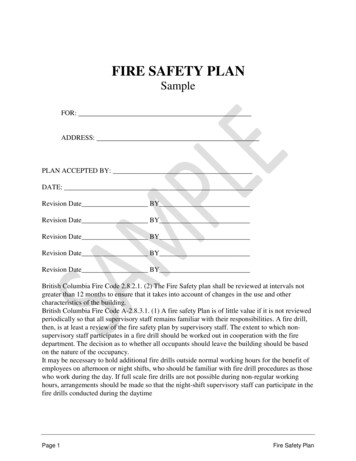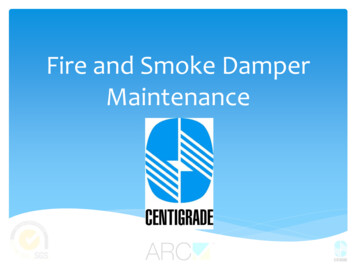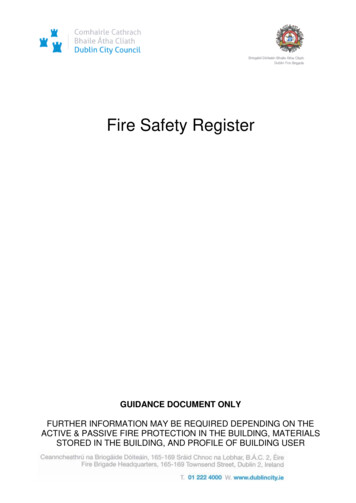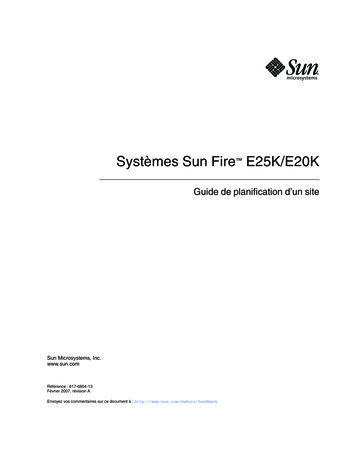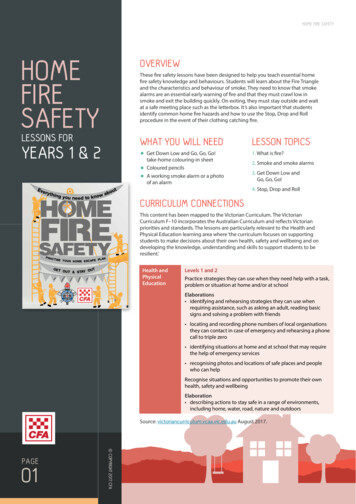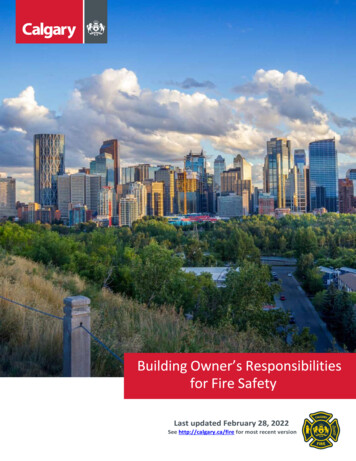
Transcription
Fire Safety Maintenance RequirementsSee http://calgary.ca/fire for most recent version
Fire Safety Maintenance RequirementsFire Code Requirements for theMaintenance of Buildings and LifeSafety SystemsCalgary Fire Department Inspections has prepared thisreference document listing common fire safety maintenancerequirements as found in the National Fire Code – 2019Alberta Edition. With some exceptions, these requirementsapply to all buildings in the City of Calgary. For a complete listof requirements see the National Fire Code – 2019 AlbertaEdition – also referred to as NFC(AE).ContentsResponsibilities . 3Definitions. 3On-Site Retention of Records . 4General Requirements . 5Commercial Cooking Operations . 6Emergency Lighting, Exit Lighting & Exit Signs . 7Electromagnetic Locks . 8Emergency Generator Systems . 10Fire Alarm & Voice Communication Systems . 11Hazardous Processes and Operations . 12Health Care Facilities . 13High Buildings . 13Integrated Systems Testing. 14Portable Fire Extinguishers . 15Water-Based Fire Protection Systems . 16Emergency Planning . 18Who is an Owner?The Safety Codes Act under which NFC(AE) is applied, definesan “owner” to include a lessee, a person in charge, a personwho has care and control and a person who holds out thatthe person has the powers and authority of ownership orwho for the time being exercises powers and authority ofownership.Who is Qualified?Persons who install, inspect, test and maintain life safetysystems must be qualified for the specific system. Thistypically means that the person will either be ajourneyperson electrician, certified fire alarm technician,journeyperson sprinkler system installer or other qualifiedperson as per provincial or Calgary Fire Departmentrequirements. Accordingly, owners are responsible forensuring that the persons they hire are qualified.For additional information on who is qualified to install andmaintain life safety equipment in Calgary, visitcalgary.ca/firecodes or contact Calgary Fire Inspectionsthrough 311.Consequences for Failing to ComplyAs per the Safety Codes Act, Section 68(1), owners failing tocomply with maintenance requirements as identified in theNFC(AE) may be subject to fines of not more than 100,000and/or imprisonment for a term not exceeding 6 months forthe first offence. Second and subsequent offences may besubject to a fine of not more than 500,000 and/orimprisonment for a term not exceeding 12 months.Appendix A: On-Site Records Checklist . 22Revision History . 232
Fire Safety Maintenance RequirementsResponsibilitiesDefinitionsIf any fire safety equipment is discovered to beinoperative or defective through maintenance,CORRECTIVEACTIONmustbetakenIMMEDIATELY by the owner or owner’sauthorized agent.AUTHORITY HAVING JURISDICTION (AHJ) means a safetycodes officer in the fire discipline exercising authoritypursuant to designation of power and terms of employmentin accordance with the Safety Codes Act.Failure to take CORRECTIVE ACTION in a timelymanner may be deemed to be a violation of theSafety Codes Act, and may result in actions beingtaken against the owner(s) in care and control.CHECK means a visual observation to ensure the device orsystem is in place and is not obviously damaged orobstructed.INSPECT means physical examination to determine that thedevice or system will apparently perform in accordance withits intended function.Responsible PartiesITM means “Inspection, Testing & Maintenance”Unless otherwise specified, the owner or the owner’sauthorized agent shall be responsible for carrying out theprovisions of this Code.MAINTENANCE means work performed to keep equipmentoperable.NFC(AE) Div. C 2.2.1.1.(1)NBC(AE) means the National Building Code – 2019 AlbertaEdition, previously known as the “Alberta Building Code”(ABC)Shutdown of Fire Alarm SystemsIf a fire alarm and detection system, or part thereof, isinoperative for more than 2 hours for any reason, the ownershall notify the fire department via 311, and when directed,provide acceptable surveillance within the buildingcontinuously until the fire alarm and detection system isrestored to operating condition.NFC(AE) Div. B 2.8.2.8.(1)Repairs or Alterations to Life Safety SystemsBefore repairs or alterations are made to fire protectioninstallations, including but not limited to fire extinguishingsystems and fire alarm and detection systems, a procedure ofnotification acceptable to the fire department shall beestablished, and the procedure may include the notificationof the fire department and the building occupants.NFC(AE) Div. B 6.1.1.3.(1)Notification of Uncorrected DefectsIf a person who carries out the maintenance of fireprotection installations discovers that a device or system isinoperative or defective and the owner or their authorizedagent is unwilling or unable to correct the defect, the personcarrying out the maintenance shall (within 10 days) notify thefire department and the owner/authorized agent.NFC(AE) means the National Fire Code – 2019 AlbertaEdition, previously known as the “Alberta Fire Code” (AFC)OWNER means a lessee, a person in charge, a person whohas care and control and a person who holds out that theperson has the powers and authority of ownership or who,for the time being, exercises the powers and authority ofownership.SUPERVISORY STAFF means those occupants of a buildingwho have some delegated responsibility for the fire safety ofother occupants under the fire safety plan.TEST means operation of device or system to ensure that itwill perform in accordance with its intended function.WATER-BASED FIRE PROTECTION SYSTEMS include sprinklersystems, standpipes, private hydrants, hose systems, waterspray fixed systems, foam-water sprinkler systems, foamwater spray systems, and fire pumps.NFC(AE) Div. B 6.1.1.3.(2)3
Fire Safety Maintenance RequirementsOn-Site Retention of RecordsOwners or their authorized agents who are unable toproduce records in a timely manner will be subject toactions under the Alberta Safety Codes Act.To comply with these requirements, the Calgary FireDepartment recommends maintaining a printed copy ofthese records organized in an easy-to-find physical binderlabeled “Life Safety Records.” These records are essential forsuccessful inspections and ongoing maintenance of buildinglife safety systems.This binder must be located in one of the following locations:1.2.3.Fire Safety Plan box found near the main entranceCentral Alarm and Control Facilities (CACF) Room, ifyour building is equipped with one.On-site central records keeping room, forinstitutions that manage multiple buildings locatedin one physical area (e.g.: hospital complexes, largeeducational institutions, large industrial sites). Inthese instances, one binder per building is required.Records to be RetainedThe following is a list of records that are frequently examinedby Fire Safety Codes Officers. Exact records required for yourbuilding are determined by the life safety systems, processesand activities in your building. For clarification on what isrequired in your building, contact Calgary Fire DepartmentInspections via 311.See “Appendix A – Records Checklist” for an insert that maybe used to ensure all required records are present in the “LifeSafety Records” binder.Record TypeCommercial Cooking Exhaust and FireProtection Systems,Doors with Electromagnetic Locks – Testas per Calgary Fire DepartmentrequirementsThis specific record type may be kept inthe generator room or with all otherrecords in the “Life Safety Records”binder.1.Voice Communication SystemsRecords of fire evacuations and fire safety drills shall beretained at the premises for examination.NFC(AE) Div. C 2.2.1.2.(2)4.5.The initial verification or test reports for each systemshall be retained throughout the life of the systems.NFC(AE) Div. C 2.2.1.2.(3)Initial, Monthly, 6Month, Annual, 5 YearAnnualFire Alarm &Initial, AnnualFire DrillsAs requiredFire Safety Plan – see EmergencyPlanningReviewed Annually byowner or owner’s agentIntegrated Systems Testing ReportAs requiredMake-up Air Systems and CO/N20detectors in enclosed parkadesULC Monitoring Certificate3.AnnualEmergency Generator SystemsEmergency Lighting2.Initial, 6 MonthOther Special Fire Suppression SystemsRequirementsThe original or a copy of records required by the NFC(AE)shall be retained at the premises for examination.NFC(AE) Div. C 2.2.1.2.(1)Frequency(Protective Signaling System only)Water-Based Fire Protection Systemsincluding but not limited to: Fire PumpsPrivate HydrantsSprinklersStandpipesAnnualCurrent certificate whereapplicableInitial, Annual, 3-yearand 5-year recordswhere applicableRecords of tests, inspections, maintenance oroperational procedures undertaken after the initial testsreferred to in #3 shall be retained so that at least thecurrent and previous record is available.NFC(AE) Div. C 2.2.1.2.(4)Proof of Deficiency ResolutionNo record shall be destroyed within two years of havingbeen prepared.NFC(AE) Div. C 2.2.1.2.(5)Where deficiencies are noted on reports, subsequently issuedletters and/or updated reports from qualified person(s) thatspeak to these deficiencies must be retained with theoriginally issued report as proof of resolution.4
Fire Safety Maintenance RequirementsOngoing RequirementsGeneral RequirementsIn addition to the requirements outlined elsewhere in thisdocument (e.g., emergency generators, fire alarms, waterbased fire protection systems), the following generalrequirements apply to most buildings.Code references noted below with an asterisk (*) requirewritten records as per NFC(AE) Division C, Article 2.2.1.2.DailyFire Doors – CHECK doors in fire separations toensure they remain closed, unless equippedwith hold-open devices conforming to NBC(AE)WeeklyHoods, Ducts and Filters in Ventilation Systems– INSPECT for accumulation of combustibledeposits and clean as Exit Doors – TEST all doors forming a part of ameans of egress to ensure they are operable2.7.2.1.(1)Fire Doors – OPERATE all doors in fireseparations to ensure they are maintained asper Sentence 2.2.2.4.(1)2.2.2.4.(3)Fire Safety Measures in Daycares – INSPECT inconformance with fire safety plan for fireprevention2.10.4NFC(AE)Access Panels and Windows – MAINTAIN freeof obstruction where provided to facilitateaccess for firefighting operations2.5.1.2Chimneys, Flues and Flue Pipes – MAINTAINby cleaning to keep them free of dangerousaccumulations of combustible deposits;replace or repair as per Sentence 2.6.1.4.(3);MAINTAIN clearances between chimneys, fluepipes, or appliances and combustibleconstruction as per NBC(AE)2.6.1.4.(2)2.6.1.5.(1)Closures in a fire separation (doors, shutters,dampers, etc.) – INSPECT and MAINTAIN sothat defects are corrected and closures areoperable at all times; repair where damagedto MAINTAIN the integrity of their fireprotection ratingCombustible Materials – CHECK to ensurematerials are not accumulating in any part ofan elevator shaft, ventilation shaft, means ofegress, service room or service space, or beingstored in crawl spaces, ceiling spaces or roofsDoor Release Hardware, Latches and Locks –MAINTAIN in good working condition at alltimes2.2.2.42.2.2.22.4.1.12.7.2.1.(6)Electrical Installations – Use and MAINTAIN soas to not constitute an undue fire hazard2.4.7.1Exterior Passageways and Exit Stairs –MAINTAIN free of snow and iceaccumulations; MAINTAIN equipment used tomelt snow or ice2.7.1.7Every 6 MonthsNFC(AE)Special Fire Suppression Systems – TEST,INSPECT and MAINTAIN systems as per theappropriate NFPA code as per NFC(AE) Div. B,Article 2.1.3.56.6.1.1 *Fire Department Access – ENSURE streets,yards and roadways that are provided for firedepartment access are kept clear2.5.1.5AnnuallyNFC(AE)Fire Department Connections – MAINTAINfree of obstructions at all times2.5.1.4Fire Separations – Repair where damaged toMAINTAIN the integrity of the fire separation2.2.1.2Chimney Spark Arrestors – INSPECT, CLEANand repair burnt-out arrestorsChimneys, Flues and Flue Pipes – INSPECT2.6.2.32.6.1.4.(1)Doors (Revolving) – TEST safety features2.7.2.1.(2) *Doors (Sliding) – TEST sliding doors that arerequired to swing on their vertical axis in thedirection of egress when pressure is applied2.7.2.1.(3) *Doors with Electromagnetic Locks – TEST toensure they work properly2.7.2.1.(4) *Fire Dampers, Smoke Dampers and Fire StopFlaps – INSPECT and TEST as per NFPA 80-20132.2.2.4Fire Safety Plan – REVIEW for changes in useand other characteristics of the building2.8.2.1.(2)Mechanical Air-Conditioning and VentilatingSystems, Exhaust and Make-up Air Systems –TEST system initiating devices (CO/N2Odetectors) in enclosed parkades; OPERATEdisconnect switches2.6.1.6.(2) *Flame-Retardant Treatments – MAINTAIN byrenewing as often as is required to ensure thatthe material will pass the match flame test inNFPA 705-2018Heating, Ventilating and Air-ConditioningSystems, including appliances, chimneys andflue pipes – Operate and MAINTAIN so as notto create a hazardous condition2.3.2.22.9.2.12.6.1.6.(1)Laundry Equipment – CHECK and empty linttraps to prevent lint from accumulating2.4.1.4Means of Egress – MAINTAIN in good repairand free of obstructions2.7.1.65
Fire Safety Maintenance RequirementsCommercial Cooking OperationsNFC(AE) Division B, Article 2.6.1.9 requires that commercial cooking equipment and fire protection systems be designed andinstalled in conformance with the applicable building code, and that the use, inspection and maintenance of commercial cookingequipment exhaust and fire protection systems be in conformance with NFPA 96-2017, “Ventilation Control and Fire Protection ofCommercial Cooking Operations.”Written records shall be maintained as per NFPA 96 and retained on-site for examination by the AHJ. A report must be completedby a qualified person for each maintenance frequency described below and kept on-site for two years.Inspection, Testing and Maintenance Requirements“Exhaust Systems” in the table below include Hoods, Grease Removal Devices, Fans and Ducts for Commercial Cooking Equipment.Frequency of MaintenanceRequirementsMonthlyINSPECT and CLEAN as required as per NFPA 96Every 3 MonthsINSPECT and CLEAN as required as per NFPA 96Every 6 MonthsINSPECT and CLEAN as required as per NFPA 96Every 6 MonthsINSPECT and MAINTAIN as per NFPA 96 11.2 and other applicable standards (e.g., NFPA 17A“Wet Chemical Extinguishing Systems”)AnnuallyINSPECT and CLEAN as required as per NFPA 96Inspection vs. Cleaning of Exhaust SystemsAll exhaust systems must be inspected at the applicable maintenance frequency as outlined above as per NFPA 96 11.4. Adetermination of whether cleaning is required will be made on the basis of NFPA 96 11.6, including use of the depth gauge comb asdescribed in the standard. This determination can only be made by the qualified person who inspects the system.Additional Requirements1.2.3.4.5.Hoods, grease removal devices, fans, ducts, and other appurtenances shall be cleaned at frequent intervals to preventsurfaces from becoming heavily contaminated with grease or other residues.Flammable cleaning materials or solvents shall not be used for the cleaning of exhaust systems.Instructions for manually operating the fire protection systems shall be posted conspicuously in the kitchen as part of thefire safety plan.Commercial cooking equipment that is certified shall be installed and maintained in conformance with its certification.Uncertified commercial cooking equipment (where permitted) shall be installed and maintained so as not to create a firehazard.Deficient SystemsDeficiencies in exhaust systems (e.g., leaking welds) or in the fire protection system are required to be repaired in a timely mannerto ensure the integrity and functionality of the system. At a minimum, “timely manner” means “before the next regularly scheduledmaintenance period” but inoperative systems must be repaired immediately for system use to continue.6
Fire Safety Maintenance RequirementsEmergency Lighting, Exit Lighting & Exit SignsNFC(AE) Division B, Articles 6.5.1.6, 6.5.1.7 and 6.5.1.8 require the inspection, testing and maintenance of Unit Equipment,Emergency Lights and Exit Signs.Written records for all annual inspection, testing and maintenance shall be retained on-site for examination by the AHJ. See OnSite Retention of Records for more information.Inspection, Testing and Maintenance RequirementsFrequencyRequirementsOngoingNFC(AE) 2.7.3.1.(2)Exit Lighting and Exit Signs – CHECK to ensure they are illuminated during times when thebuilding is occupiedMonthlyNFC(AE) 2.7.3.1.(3)Emergency Lighting (self-contained units) – INSPECT, TEST and MAINTAIN batteries, unitsand lamps as per Article 6.5.1.6Exit Signs with Battery Back-up – INSPECT to ensure visibility upon failure of the primarypower supply as per 6.5.1.8.(2)(a)Annually *Emergency Lighting (self-contained units) – INSPECT, TEST and MAINTAIN batteries, unitsand lamps as per Article 6.5.1.6Emergency Lights (other than self-contained units) – INSPECT to ensure they arefunctional as per Article 6.5.1.7Exit Signs – INSPECT and TEST to ensure visibility upon failure of the primary power supplyand, where equipped with battery back-up, for the design criterion as per Article 6.5.1.8Deficient SystemsAll deficiencies are to be repaired to maintain the functionality and design criterion of the equipment.Who is Qualified?Building operators/maintenance personnel, fire alarm technicians and electricians.7
Fire Safety Maintenance Requirements7Electromagnetic LocksNFC(AE) Div. B 2.7.2.1 requires that, when doors areequipped with electromagnetic locks, these locks be tested atintervals not greater than 12 months.Electromagnetic locks that malfunction or are not installed tocode pose a significant threat to building occupants andemergency responders. To ensure that these locks aremaintained, an itemized, dated and signed report issued by aqualified person (journeyperson electrician or fire alarmtechnician) must be completed annually, retained for 2 yearsand made available to the AHJ upon request.*The report must speak to the operation of each magnetic lockon the premises. Each lock must be tested to ensurecompliance with building code at time of installation.1Test Details and ReferenceLocation of doorNFC(AE) Div. B 2.7.2.123Releases upon actuation of thealarm signal from the building’s firealarm system **NBC(AE) Div. B 3.4.6.16.(4)(b)Releases upon loss of powercontrolling the electromagneticlocking mechanism and associatedauxiliary controlsBuildings built under ABC 1990 untilABC 2014 permitted 30 second totaltime delayNBC(AE) 201915 secondsABC 1990 – 201430 secondsABC 2014 Div. B 3.3.1.13.(10).9Where a bypass switch is installed toallow testing of the fire alarmsystem, actuation of the switchcomplies with NBC(AE)NBC(AE) 2019NBC(AE) Div. B 3.4.6.16.(4)(i)10AFC 199711ABC 1990The total time delay for allelectromagnetic locks in any path ofegress to release is not more than 15secondsNBC(AE) Div. B 3.4.6.16.(4)(h)Applies SinceABC 1990ABC 1990NBC(AE) Div. B 3.4.6.16.(4)(g)8Test for All Occupancies except B2/B3Test #Has a legible sign permanentlymounted on the door to indicatethat the locking device will releasewithin 15 seconds of applyingpressure to the door openinghardwareEmergency lighting is provided ateach doorNBC(AE) Div. B 3.4.6.16.(4)(j)If the electromagnetic lock isinstalled on a door providingemergency crossover access to floorareas from exit stairs in accordancewith NBC(AE) Div. B 3.4.6.18,complies with NBC(AE)NBC(AE) 2019NBC(AE) 2019NBC(AE) Div. B 3.4.6.16.(4)(k)NBC(AE) Div. B 3.4.6.16.(4)(c)456Releasesimmediatelyuponactuation of a manually operatedswitch “readily accessible only toauthorized personnel”NBC(AE) Div. B 3.4.6.16.(4)(d)A force of not more than 90 Napplied to the door openinghardware initiates an irreversibleprocess that releases the lockingdevice within 15 seconds and doesnot re-lock (crossover doorsexcepted – see Test #11)NBC(AE) Div. B 3.4.6.16.(4)(e)Upon release, requires the lockingdevice to be manually reset by theactuation of the operated switch“readily accessible only to authorizedpersonnel”NBC(AE) Div. B 3.4.16.(4)(f)ABC 1990ABC 1990Crossover doorssince NBC(AE)2019* Annual fire alarm inspection and testing only refers to theoperation of ancillary device circuits for door release. As such,these reports are not considered appropriate tests ofelectromagnetic locks.** Note that where a 2-stage fire alarm is installed, alarmsignals differ from alert signals, however release uponactuation of an alert signal from the building’s fire alarmsystem is also permitted.ABC 19908
Fire Safety Maintenance RequirementsTest for Electromagnetic Locks withinGroup B, Division 2 and Division 3OccupanciesThis test is only available for buildings built under AlbertaBuilding Code (ABC) 2014 with Fire Code Variance STANDATA14-FCV-012 or those built under 2019 NBC(AE) or later. Allother buildings must comply with electromagnetic locks asper the applicable building codes.Test #1Test Details and ReferenceLocation of doorNFC(AE) Div. B 2.7.2.12Releases upon actuation of thealarm signal from the building’s firealarm system8The operation of any by-pass switch,where provided for the testing of thefire alarm system, sets off an audibleand visual signal at the fire alarmannunciator panel and at themonitoring station referred to bySentence 3.2.4.7.(4)ABC 2014NBC(AE) Div. B 3.4.6.16.(5)(e)9Emergency lighting is provided at thedoorsABC 2014NBC(AE) Div. B 3.4.6.16.(5)(f)Applies SinceAFC 1997ABC 2014NBC(AE) Div. B 3.4.6.16.(5)(b)(i)3Releases upon loss of power supplyand power to maglock auxiliarycontrolABC 2014NBC(AE) Div. B 3.4.6.16.(5)(b)(ii)4Releases upon actuation of amanually operated switch that isreadily accessible at a constantlyattended location within the lockedspaceABC 2014NBC(AE) Div. B 3.4.6.16.(5)(b)(iii)5Releases upon actuation of themanual station installed within 0.5 mof each door and equipped with anauxiliary contact, which directlyreleases the electromagnetic lockABC 2014NBC(AE) Div. B 3.4.6.16.(5)(b)(iv)6Upon release, the electromagneticlock requires manual resetting byactuation of the switch referred to inSubclause (b)(iii)ABC 2014NBC(AE) Div. B 3.4.16.(5)(c)7A legible sign with the words“EMERGENCY EXIT UNLOCKED BYFIRE ALARM” written in letters atleast 25 mm high with a stroke of atleast 5mm wide is permanentlymounted on the door (in thedirection of travel)NBC(AE) Div. B 3.4.6.16.(5)(d)ABC 20149
Fire Safety Maintenance RequirementsEmergency Generator SystemsNFC(AE) Division B, Section 6.5 requires that emergency generators and related systems be maintained as per CSA C282-15,“Emergency Electrical Power Supply for Buildings.”Written records for all inspection, testing and maintenance shall be retained on-site for examination by the AHJ. These recordsmay be kept in the same location as other on-site records or in the generator room. See On-Site Retention of Records for moreinformation.Inspection, Testing and Maintenance RequirementsFrequencyRequirementsInitial Acceptance TestsRetain acceptance documentation on-site for the life of the systemWeekly – for Health Care Facilities onlyINSPECT, TEST and MAINTAIN as per CAN/CSA C282-15 Table #2 and Table #3Weekly – for All Other FacilitiesINSPECT, TEST and MAINTAIN as per CAN/CSA C282-15 Table #2MonthlyINSPECT, TEST and MAINTAIN as per CAN/CSA C282-15 Table #3Every 6 MonthsINSPECT, TEST and MAINTAIN as per CAN/CSA C282-15 Table #4AnnuallyINSPECT, TEST and MAINTAIN as per CAN/CSA C282-15 Table #5Every 5 YearsINSPECT, TEST and MAINTAIN as per CAN/CSA C282-15 Table #6Deficient SystemsGenerators that are found to be deficient, through inspection and testing, are required to be repaired (maintained) in a timelymanner to serve the original power requirements and design of the emergency system. Generators shall not be de-rated by anyoneother than a professional engineer, who through training and experience, may competently speak to the power requirements ofthe systems that depend on the emergency generator system.Where an annual load test cannot be completed due to a deficiency in the generator, the load test must be repeated to successfulconclusion following repairs to the generator.Who is Qualified?Weekly and Monthly inspection, testing and maintenance may be completed by Building Operators/Maintenance Personnel whohave received and can prove (certificates, transcripts, letter of competency, etc.) training by the generator manufacturer.Inspection, testing and maintenance for all other frequencies (semi-annual, annual, 5-year) may only be performed by persons whohave received and can prove (through certificates, transcripts) training by the generator manufacturer, where required by themanufacturer, or successful achievement in a related post-secondary field (e.g., stationary engineer).10
Fire Safety Maintenance RequirementsFire Alarm & Voice Communication SystemsNFC(AE) Division B, Section 6.3 outlines requirements for fire alarm and voice communication systems (e.g., fire phones), andrequires that fire alarm systems be inspected and tested in conformance with CAN/ULC-S536-13.Written records for all monthly and annual inspection, testing and maintenance shall be documented as per CAN/ULC-S536 andretained on-site for examination by the AHJ. See On-Site Retention of Records for more information.Inspection, Testing and Maintenance RequirementsFrequencyRequirementsDaily – Fire AlarmCAN/ULC-S536 Subsection 5.1CHECK for trouble on primary or remote trouble indicatorsCHECK status of primary power “on” or equivalent indicatorMonthly – Fire AlarmCAN/ULC-S536 Subsection 5.2INSPECT and TEST on emergency power supply to confirm operability of fire alarm system asper CAN/ULC-S536. It is recommended that monthly tests be coordinated with emergencypower generator tests, where applicable. Written records are required to be maintained as perCAN/ULC-S536.The monthly test is not required in the month that the annual inspection, testing &maintenance is conducted.Monthly – Voice CommunicationWhere such systems are part of the building evacuation plan and not otherwise electronicallysupervised, TEST as per NFC(AE). Keep written records of tests and outcomes.Annual – Fire AlarmCAN/ULC-S536 Section 6INSPECT and TEST the system as per CAN/ULC-S536 by qualified persons acceptable to AHJ.Written records are required to be maintained as per CAN/ULC-S536.For the purposes of this standard, an annual inspection shall be held within a period notexceeding 12 months from the date of the previous annual inspection.Smoke Detectors 10 Years of Age – Where not otherwise automatically tested by the firealarm system, TEST for sensitivity or replace as per NFC(AE) Div. B 6.3.1.2.(4)Annual – Voice CommunicationTEST the system as per NFC(AE) by qualified personnel acceptable to the AHJ. Keep writtenrecords of tests and outcomes.Additional Requirements1.2.3.4.Fire alarm and voice communication systems shall be maintained in operable condition at all times.Fire alarm and detection system components shall be accessible for purposes of inspection or maintenance.If a fire alarm or sprinkler system is required to transmit a signal to the fire department in conformance with NBC(AE), theconnection shall be operational at all times.Requirements for annual smoke detector sensitivity testing outlined in Subsection 6.7.4 of CAN/ULC-S536 shall not applyuntil a smoke detector has been in place for 10 years.Who is Qualified?Daily and Monthly inspection and testing may be performed by building operators who have received and can prove (certificate orletter of competency) training by the fire alarm system manufacturer or service provider for their specific fire alarm system.Annual inspection, testing and maintenance may only be performed by qualified persons as per NFC(AE). See calgary.ca/firecodesand Fire Interpretation STANDATA 19-FCI-007, “Existing Fire Alarm Systems” and Fire Interpretation STANDATA 19-FCI-008,“Qualifications and Approvals” for further information on who is qualified in these situations.11
Fire Safety Maintenance RequirementsHazardous Processes and OperationsRequirements for Hazardous Processes and Operations are covered under Part 5 of NFC(AE). Anyone engaging in activities regulatedby this part of the fire code is expected to be familiar with the applicable regulations.Written records may be required depending on the activity and regulation, and many situations require special consideration in aFire Safety Plan. Refer to the appropriate regulation and On-Site Retention of Records for more information.Common Hazardous ActivitiesActivityNFC(AE)Dipping and Coating Processes – MAINTAIN as per NFPA 34-20165.4.6.2Dust-Producing Operations – MAINTAIN (by cleaning) building and machinery of any combustible dustproduced5.3.1.25.3.2.2Industrial Ovens – INSPECT, MAINTAI
Shutdown of Fire Alarm Systems If a fire alarm and detection system, or part thereof, is inoperative for more than 2 hours for any reason, the owner shall notify the fire department via 311, and when directed, provide acceptable surveillance within the building continuously until the fire alarm and detection system is




